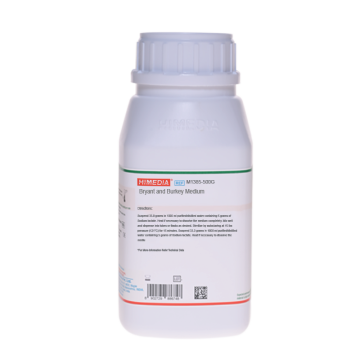 Your enquiry has been submitted
Your enquiry has been submitted
Bryant and Burkey Agar
Bryant and Burkey Agar is used for detecting and enumerating spores of lactate fermenting Clostridium in milk and dairy products.
Composition**
| Ingredients | Gms / Litre |
|---|---|
| Casein enzymic hydrolysate | 15.000 |
| Yeast extract | 5.000 |
| Beef extract | 7.500 |
| Sodium acetate | 5.000 |
| L-Cystine hydrochloride | 0.600 |
| Resazurin | 0.0025 |
| Sodium thioglycollate | 0.200 |
| Agar | 0.750 |
Final pH ( at 25°C): 5.9±0.2
**Formula adjusted, standardized to suit performance parameters
Directions
Suspend 34.05 grams in 1000 ml distilled water containing 3 grams of Sodium lactate. Heat to boiling to dissolve the medium completely. Sterilize by autoclaving at 15 lbs pressure (121°C) for 15 minutes.
Note : If more than the upper one-third of the medium has acquired a pink colour, the medium may be restored once by heating in a water bath or in free flowing steam until the pink colour disappears.
Principle And Interpretation
Bryant and Burkey Agar is used to enumerate the spores of gasogenic clostridia that are responsible for swelling of cheese in dairy industry (1, 2). In normal conditions of use, the medium allows the growth of other microorganisms also which are not directly related to cheese alteration, e.g. Clostridium sporogenes or Clostridium butyricum. Germination and growth of butyric acid bacteria (BAB) causes severe defects in cheese with silage being the main source of BAB spores in cheese milk (4). Clostridia spores are heat resistant and therefore can contaminate cheese brines. The gas produced by the growth of clostridia swells the cheese and is responsible for defect known as butyric swelling, resulting in bad taste. The main species causing this butyric swelling defect is Clostridium tyrobutyrium.
Bryant and Burkey Agar is the modification of Bryant and Burkey Medium with addition of little amount of agar that makes the medium thicker to be used in greater volumes. Addition of sodium thioglycollate maintains anaerobic conditions and also the amount of lactate is reduced so that the density of the medium will be retained easily for the production of gas bubbles.
Resazurin is a redox indicator and monitors the oxygen level turning from pink under aerobic conditions to colourless under anaerobic conditions. The nutrient composition of the basal medium, particularly of casein enzymic hydrolysate, yeast extract, beef extract and L-cystine HCl help in rapid growth of Clostridium species. Sodium acetate promotes spore germination (3) and improves the selectivity of the medium. Sodium lactate is fermented under anaerobic conditions by Clostridium tyrobutyrium. A pink colour indicates the presence of oxygen in the media which turns colourless on boiling.
Quality Control
Appearance Cream to yellow homogeneous free flowing powder
Colour and Clarity of prepared medium Light amber coloured, clear to slightly opalescent solution with upper 10% or less medium pink on standing.
Reaction Reaction of 3.4% w/v aqueous solution at 25°C. pH : 5.9±0.2 (pH range 5.70-6.10)
Cultural Response
M1690: Cultural characteristics observed under anaerobic condition, after an incubation at 35-37°C for 6 days.
| Organism | Inoculum (CFU) | Growth | Gas production |
|---|---|---|---|
| Clostridium tyrobutyricum ATCC 25755 | 50-100 | good | positive reaction |
Storage and Shelf Life
Store below 30°C in tightly closed container and the prepared medium at 2 - 8°C. Use before expiry date on the label.
Reference
- Bryant M. P. and Burkey L. A., 1956, J. Bacetriol., 71: 43-46.
- Bergeres J. L. and Sivela S., 1989, Detection and enumeration of Clostridial spores related to cheese quality-Classical and new methods, FIL-IDF Bull. 51:18-23.
- Touraille C. and Bergere J. L., 1974, Biochimie, 56: 404-422.
- Vissers M. M. M., Drichuis F., Giffel T., John P. D., Lankveld J. M. G., 2007, J. Dairy Sci., 90:928
| Product Name | Bryant and Burkey Agar |
|---|---|
| SKU | M1690 |
| Product Type | Regular |
| Physical Form | Powder |
| Origin | Animal |
| Packaging type | HDPE |
| References | 1. Bryant M. P. and Burkey L. A., 1956, J. Bacetriol., 71: 43-46. |
| Customized Product Available | No |





